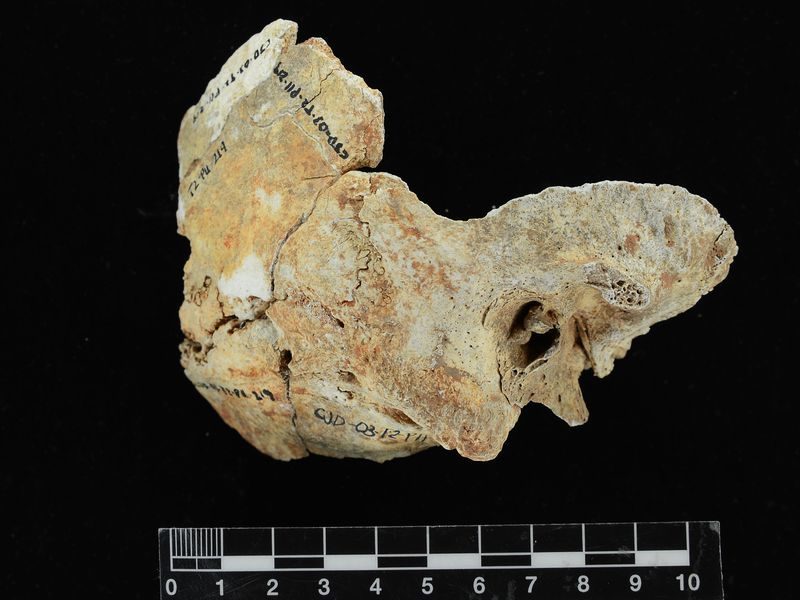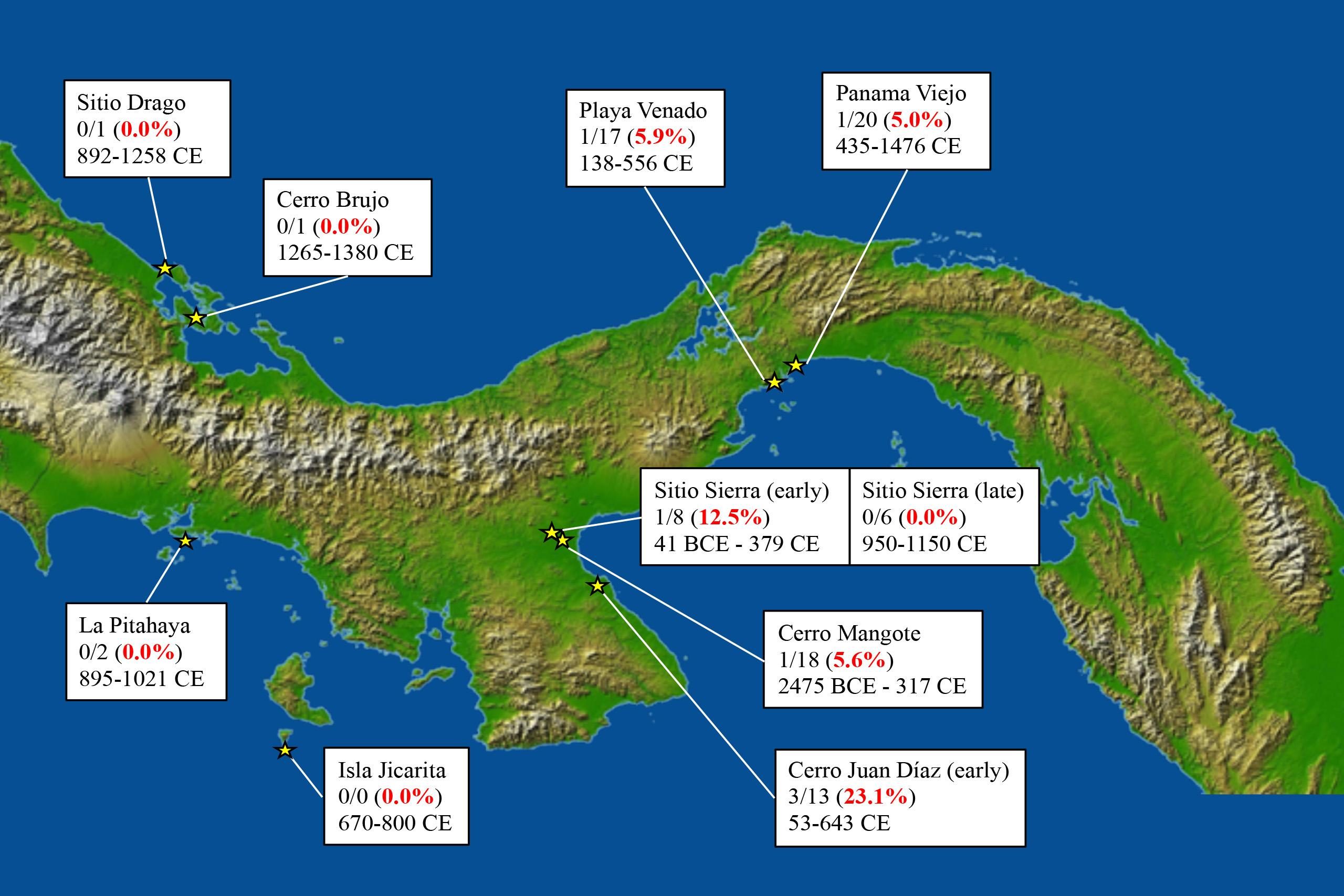
The little spur Smith-Guzmán identified had created a slight mound in the skull's ear canal-an annoying impediment for the person who once had to deal with it. Known as external auditory exostoses, or EAE, the bony masses can be globular or shaped like teardrops. Depending on their severity, these growths, commonly called "surfer's ear" today, can cause repeat ear infections and even deafness.
Scientists still don't understand the precise mechanisms behind the formation of EAE. For a time, the growths were thought to be caused by some genetic anomaly. Further research, however, pointed to a different source: repeated exposure to and submersion in cold water. Just how cold the water has to be and how often people have to swim in it remains up for debate. But for such ear canal growths to be found in human remains in a place like Panama was unexpected and perplexing.
Maybe, Smith-Guzmán thought, the first EAE she saw in 2015 was an anomaly. But she kept an eye out for more while continuing her work as a research collaborator at the Smithsonian Tropical Research Institute. Smith-Guzmán had been tasked to review the skeletons excavated by Richard Cooke in the 1970s. As she worked, more skulls afflicted by EAE appeared. And then came another surprise.
"At Cerro Juan Díaz [archaeological site], three skeletons within the same burial unit had this bony growth," Smith-Guzmán says. "At this point, you start thinking these are people who know each other during life and might be doing the same sort of activities together." And those activities might well have included diving deep into the waters of Parita Bay to retrieve oysters, shells and even pearls.
Now, after three years of work, Cooke and Smith-Guzmán have published their results in the American Journal of Physical Anthropology. Of the 125 skulls they examined from sites across Panama, they saw EAE in seven men and one woman, revealing that, in the right conditions, even the balmy tropics can become chilly enough for the ear canal to react.

"Since [all the individuals in Smith-Guzmán's study] seem to have subsisted at least in part on aquatic resources, lived in different environments in a relatively small region, and possibly were genetically comparable, the frequency and distribution of the EAE show a clear pattern," Eggers says.
That pattern is the frequent development of EAE among communities that relied heavily on fishing, diving and other activities that repeatedly brought them in contact with the water. For numerous groups in Panama, daily life included diving for thorny oysters, giant conch and pearl oysters. The shells were then used to produce ornamentation for burials.
Smith-Guzmán's paper adds to a growing body of evidence that our coastal ancestors showed no hesitation when it came to getting wet. Skulls with EAE have been found as far south as the subpolar environment of Tierra de Fuego and in hominin populations dating back to 430,000 years ago. One group of researchers studied a pair of massive EAE growths in an old male Neanderthal who lived 50,000 years ago. The condition appeared in both the individual's left and right ears, meaning he would've been largely deaf and therefore reliant on the individuals around him.
Comment: That humans, at least in the last few thousand years, 'showed no hesitation in getting wet' is hardly revelatory. And it's notable that those found in Tierra de Fuego are much more likely to have been exposed to colder temperatures which aligns with the cold water theory.
Given how far back the growths occur, some scientists have suggested they provide evidence for humankind's ongoing relationship with water. "It is highly likely that the presence of these growths constituted a selective survival advantage for early hominids during evolution," write Rhys Evans and M. Cameron in a paper for the Royal College of Surgeons. They suggest that if early hominids spent extended periods of time in the water, perhaps the development of these bone spurs protected the more vulnerable structures of the ear, like the ear drum-though today the growths are generally considered a nuisance. "Their development... as a physiological modification rather than a pathological entity may have provided an evolutionary advantage for early hominids in a marine or semiaquatic environment."
Human's passion for the water has continued to this day. The occurrence of EAE hasn't declined, despite fewer people relying on fishing for subsistence. Researchers studying 307 modern surfers found that 82.4 percent of those who had surfed for more than 10 years had severe EAE. While some surfers and divers use earplugs to prevent the bone growths, others have to rely on surgery for their removal.
Comparing ancient and modern examples of EAE is up next on Smith-Guzman's agenda. She hopes to look at archaeological sites in Costa Rica, Venezuela and Colombia, and talk to doctors around Panama City to get an idea of the modern prevalence of "surfer's ear."
There's also the matter of Panamanian skeletons to finish sorting through. Over 300 human remains still need to be examined, and with them come more questions. Did EAE occurrence change after European contact? Could Columbus' arrival have spelled a decline in diving for shells? It's impossible to say at this point, but for Smith-Guzmán, the mystery is part of what keeps her searching for more clues about pre-Hispanic life in Panama.



Comment: While it is possible that those skulls showing signs of surfers ear were merely the result of prolonged time in the "tropical" waters of Panama, they haven't actually yet checked to see whether Panamanians in our own era show evidence of EAE. According to WIki, it's notable that EAE is most often caused by: Some questions that could be asked are: Since there is evidence for significant climate shifts throughout history, is it possible that at particular periods Panama wasn't so "balmy"? And are the timings of these temperature variations reflected in those skulls that show signs of EAE? Or could it be that the divers were spending more time in the water than they usually would?
See also: